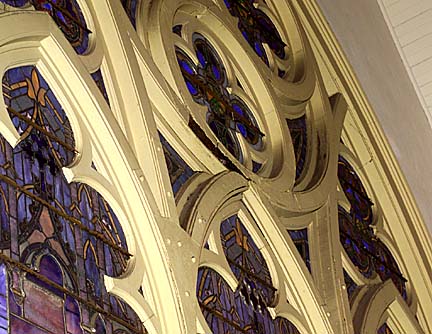


THE SAPLING GOLD TREE planted seven years ago on the Kaumakapili Church lawn bore its first blossoms this week, and church secretary Martha Dayag takes it as a symbol of the renewal project the congregation has undertaken.
Kaumakapili's laity launches
a fund drive to repair its sanctuary,
a Palama landmarkBy Mary Adamski
Star-BulletinThe 90-year-old Palama landmark looks like gray stone, one of those Gothic structures that have survived centuries in Europe.
What lay leader Henry Maunakea calls "the queen of the Hawaiian churches" is actually a stucco-covered wooden building which, as members are painfully aware, is very much the worse for wear.
A stained-glass window has been girded with wooden stripping since a big wind blew out pieces in 1998. One priceless Tiffany window remains after vandals destroyed two others in the 1960s. The bell tower is considered structurally unsound. Termite-damaged beams and holes in the plaster can be seen inside and out.

The congregation has launched a $1.25 million drive to finance reconstruction of the structure, built in 1911.A GRAND UNDERTAKING at the time, it replaced the earlier church destroyed in the Chinatown fire. Kaumakapili's history stretches back 162 years; the second Oahu church founded by Congregational missionaries, it was perceived as the church of the common folk, a counterpoint to Kawaiahao, the church of the alii.
Maunakea and Jack Keppeler, who spearhead the Sanctuary Restoration Committee, have begun face-to-face fund-raising visits to 213 individuals and families on the membership rolls.
But Keppeler said: "There are thousands all over the state who consider this church part of their family history. The legacy of families is unreal, even if they don't come here to worship."
It's a connection that arises when it's time for a wedding or funeral, and the call will come: "Long time since I came to church ... but can you help?" Kaumakapili is hoping they will want to return the favor.
The money-seekers are finding the grass-roots effort an enriching experience, and that's not just because they've already gotten pledges beyond the $100,000 goal for member donations -- with half the people on the list yet to be visited. Valuable though their skills may be -- Keppeler, president of an agricultural consultant firm, and Maunakea, sales and marketing vice president of Hunters furnishing company -- this task usually comes down to patient talk-story time.

Maunakea told of a visit to an elderly housebound kupuna. "She started out by leading us in prayer. Then she opened her Bible and peeled out a $20 bill." As they talked about the project, "she didn't say much, but her body language was everything."The woman pulled handkerchiefs out of pockets, unwrapping further clusters of bills which she handed over.
Another, said Keppeler, was an old tradesman who asked pointed questions about the damage that needs fixing. He "can't write a check for $1,000, but he can organize $50,000 worth of work."
"Our call for kokua is drawing out a tremendous force," he said. Construction workers have volunteered their time and talent. Whether they are used will depend on the contractor, to be chosen later this year, and resolution of liability concerns.
FROM THE VERY FIRST church council discussion of the project last fall, "we have been aware that we need to be seeking God's help in all this," said Maunakea.

Each meeting with a potential donor begins with reflection on the Gospel of Matthew, verses in which Jesus talked about giving. He said, "Do not store up for yourselves treasures on earth, where moth and rust destroy," and, "When you give to the needy, do not let your left hand know what your right hand is doing, so that your giving may be in secret. Then your Father, who sees what is done in secret, will reward you."Keppeler said: "From the beginning, the question we asked was, 'Should there still be a Kaumakapili? Is there a need on Palama Street for witnessing the gospel?'
"There is a purpose ... but there is a cost. This is going to take years of inconvenience," he said.
Pressure to give doesn't come into play in the grass-roots drive. "If someone can only give $5, that's what God is having them do," said Maunakea. "Hawaiians are a very economical people."
That's the older generation, Keppeler chimed in. The next generation is "more likely to ask, 'What's the going rate?' And the grandchildren say we should have a Web site."
As much as they hope for help from the extended family with Kaumakapili roots, the bulk of funding is being sought from corporations, trusts and foundations. Kamaaina businessmen Kenneth F. Brown and Samuel A. Cooke are spearheading that $925,000 effort. Church member Hardy Spoehr, a professional grant-writer, is preparing the requests.
Maunakea displayed some of the grant applications, each an inch thick, each specific to the foundation, each a different form of talk-story time.
Contributions to the restoration project may be mailed to: Contributions:
Sanctuary Restoration CommitteeChecks should be made out to Kaumakapili Church. For more information, call 808-845-0908.
Kaumakapili Church
766 N. King Street
Honolulu, HI 96817